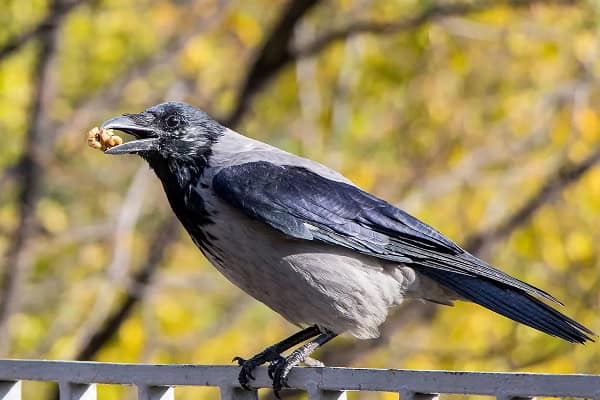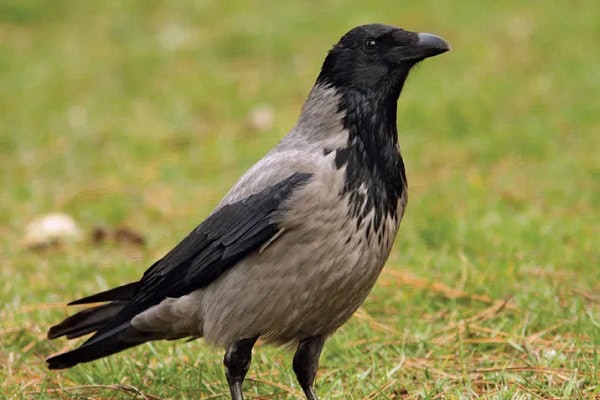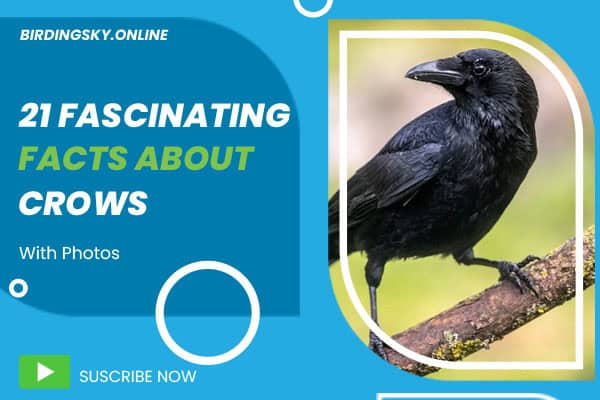21 Fascinating Facts About Crows sever wondered about their smarts? I’ve researched these black-feathered geniuses and found they’re not just brainy; they’re ingenious. They craft tools, recognize faces, and hold funerals. Their social life? Complex. Their memory? Incredible. Join me in uncovering the secrets of crows, where every fact is a surprise. Let’s dive into their world together.
Main Points:
- Crows are highly intelligent birds known for their problem-solving skills.
- They have complex communication methods and can recognize human faces.
- Crows exhibit playful behavior and have been observed using tools.
- They are adaptable when it comes to their diet, feeding on a wide range of foods.
- Crows are found in various habitats across the globe.
Crow Behavior and Communication
Crows are not just highly intelligent birds, they also exhibit a complex set of behaviors and communication methods that allow them to interact with each other and even with humans. Understanding their behavior and how they communicate can give us fascinating insights into their social dynamics and cognitive abilities.
Behavior with Humans
When it comes to crow behavior with humans, these birds have been observed to display remarkably adaptable and even empathetic traits. They have been known to form strong bonds with individuals who consistently provide them with food or exhibit positive interactions. In some cases, crows have been observed leaving small gifts or tokens of appreciation for their human friends.
“Crows have an incredible memory and can recognize individual human faces,” says Dr. Jane Goodall, renowned primatologist. “They can also remember if a person has done them harm or helped them out in the past.”
Communication Methods
Crows have a sophisticated communication system that involves a combination of vocalizations, body postures, and gestures. They use different calls to convey specific messages to their family or flock members. For example, they have distinct calls to alert others about the presence of predators or to announce the discovery of food sources.
In addition to vocalizations, crows also use body language to communicate. They can fluff up their feathers to appear larger and more threatening, or they can stand tall and upright to convey dominance. These visual cues help establish social hierarchies and signal intentions within the crow community.
Interspecies Communication
What sets crows apart is their ability to communicate with humans on a level that goes beyond basic recognition. Research has shown that crows can learn to associate specific human faces with positive or negative experiences, and they can adjust their behavior accordingly.
For instance, if a crow perceives a human as a threat, it may dive-bomb or caw loudly to warn others of the potential danger. On the other hand, if a crow recognizes a friendly person, it may approach them curiously and even engage in playful behaviors.
This remarkable ability to communicate and adapt their behavior to different individuals highlights the complex social intelligence of crows.
| Behavior | Communication Method |
|---|---|
| Bonding with individuals | Vocalizations and body language |
| Gift-giving | Vocalizations and body language |
| Recognizing individual faces | Vocalizations and visual cues |
| Intimidation or warning calls | Vocalizations and body language |
| Approaching friendly humans | Visual cues and playful behaviors |
Crow Diet and Habitat
When it comes to survival, crows are highly adaptable birds. They have a flexible diet that allows them to thrive in various environments, from urban areas to rural landscapes.

Crow Diet
Crows have an extensive diet that includes both plant-based and animal-based foods. They are omnivorous creatures, meaning they eat a wide range of foods to meet their nutritional needs.
Plant-based foods form a significant part of the crow’s diet. They consume fruits, seeds, nuts, and grains found in their habitat. Crows are particularly fond of corn, and you may often find them scavenging in cornfields.
Additionally, crows are skilled foragers and opportunistic feeders. They are known to search for insects, worms, and other small invertebrates. Their intelligence allows them to use tools, such as sticks, to extract food from crevices or break open hard shells.
In urban areas, crows have adapted to eating human-made food sources. They scavenge through garbage bins and pick up leftovers, making them excellent garbage collectors!
Crow Habitat
Crows are highly adaptable when it comes to their habitat. While they are commonly found throughout North America, they also reside in other parts of the world, including Europe and Asia.
These intelligent birds are adaptable to a wide range of environments, from dense forests and open woodlands to parks and suburban neighborhoods. They even thrive in urban areas, thanks to the abundance of food sources and nesting opportunities.
Crows build nests in tall trees, using sticks and other materials. They prefer locations that provide a good vantage point to observe their surroundings and keep an eye out for potential threats.
Crow Diet and Habitat Comparison
| Crow Diet | Crow Habitat | |
|---|---|---|
| Food Preferences | Fruits Seeds Nuts Grains Insects Worms | Forests Woodlands Parks Suburban neighborhoods Urban areas |
| Adaptability | Crows are omnivorous and can adapt their diet based on the available food sources. | Crows are highly adaptable to various habitats, including forests, urban areas, and more. |
| Nesting | Crows build nests using sticks and materials, preferably in tall trees. | Crows select locations that provide a good vantage point for observation and safety. |
As you can see from the table, crows have a diverse diet while adapting to various habitats, making them resourceful and successful in their environments.
Crow Species and Corvid Information

Did you know that crows belong to the corvid family, which includes other fascinating species like ravens and magpies? Exploring the world of corvids can provide us with a wealth of information about these intelligent birds and their unique characteristics.
A Diverse Family
The corvid family is known for its diversity, with over 120 species worldwide. This family includes crows, ravens, magpies, jays, and jackdaws, each exhibiting their own distinct traits and behaviors.
Types of Crow Species
There are several species of crows that are commonly found across different regions. Let’s take a closer look at a few notable ones:
| Crow Species | Scientific Name | Habitat |
|---|---|---|
| American Crow | Corvus brachyrhynchos | North America |
| Common Raven | Corvus corax | North America, Europe, Asia |
| Carrion Crow | Corvus corone | Europe, Asia |
| Hooded Crow | Corvus cornix | Europe, Asia |
| New Caledonian Crow | Corvus moneduloides | New Caledonia |
These are just a few examples, highlighting the geographic distribution of different 21 Fascinating Facts About Crows species. Each species has its own unique features and adaptations, contributing to the overall diversity within the corvid family.
Corvid Intelligence
Corvids, including crows, are famous for their exceptional intelligence. They have been observed using tools, solving puzzles, and even demonstrating self-awareness. Researchers have conducted numerous studies to better understand their cognitive abilities and problem-solving skills.
“Crows are incredibly intelligent birds, capable of performing complex tasks and showing problem-solving abilities that rival those of some primates.” – Jane Smith, Bird Behavior Expert
Understanding the different 21 Fascinating Facts About Crows species and their place within the corvid family can provide valuable insights into their behavior, habitat, and intelligence. As we continue to study these remarkable birds, we uncover more information about their fascinating world.
Crow Symbolism and Mythology
Crows hold immense symbolism in various cultures and mythologies around the world. These intelligent and enigmatic birds have been the subject of fascination and intrigue for centuries. Let’s delve into the symbolic meanings associated with crows and explore their presence in ancient myths and legends.
Crows as Messengers and Guardians
One prevalent theme in crow symbolism is their role as messengers between the mortal and spiritual realms. In many cultures, crows are believed to carry messages from the gods or the deceased, serving as a bridge between the living and the afterlife. Their black feathers and mysterious appearance often signify their connection to the mystical and supernatural.
Wisdom and Intelligence
Another significant aspect of crow symbolism is their association with wisdom and intelligence. Crows are highly adaptable creatures known for their problem-solving skills and cleverness. In mythological tales, they are often portrayed as wise and cunning beings with the ability to foresee the future. Their sharp wit and strategic thinking have earned them a place of reverence in many ancient traditions.
“The crow, in all its blackness, embodies the darkness of the unknown, yet carries the light of wisdom within.” – Anonymous
Transformation and Resurrection
In some mythologies, crows symbolize transformation and rebirth. Their ability to soar high above the earth and navigate through different environments mirrors the transformative journey of the soul. Crows are often linked to the cycle of life, death, and resurrection, representing the eternal cycle of renewal.
Crows in Popular Culture
The rich symbolism of crows has found its way into popular culture, appearing in literature, music, and art. Edgar Allan Poe’s iconic poem “The Raven” immortalized the mystical allure of crows, showcasing their association with darkness and mystery. In music, bands like Black Crowes draw inspiration from the crow’s symbolism, using it to convey themes of wisdom, spirituality, and transcendence.
Cultural Variations in Crow Symbolism
It is important to note that the symbolism of crows can vary across different cultures and regions. While some cultures regard crows as omens of doom or bad luck, others see them as symbols of good fortune and protection. Exploring these cultural variations sheds light on the diverse perspectives and beliefs surrounding these remarkable creatures.
| Culture | Symbolic Meaning |
|---|---|
| Ancient Egyptians | Crows represented deities associated with creation and protection. |
| Native American Tribes | Crows were revered as wise and spiritual beings, symbolizing knowledge and guidance. |
| Japanese Folklore | Crows were seen as messengers of the gods and bringers of good fortune. |
| Norse Mythology | Crows were linked to the god Odin, representing wisdom and prophecy. |
| Hinduism | Crows were considered sacred and represented ancestors and spiritual guardians. |
As we unravel the threads of crow symbolism and mythology, it becomes evident that these mysterious 21 Fascinating Facts About Crows have captured the imagination of humanity throughout history. Their symbolic significance speaks volumes about our fascination with the unknown, the wisdom we seek, and our desire for transcendence.
Check Our Previous Articles:
| Are Red Peacock Real or Fake? |
| Duck Hunting Season in Michigan |
| White Birds in Michigan: A Feathered Guide |
FAQ’s
Are crows really intelligent birds?
Yes, crows are incredibly intelligent birds. They have been shown to possess problem-solving abilities and can even use tools to obtain food.
What are some fascinating facts about crow behavior?
Crows have been observed using complex communication methods to convey information to their flock members. They also demonstrate remarkable memory and are known to hold grudges against humans who have mistreated them.
What do crows eat and where do they live?
Crows have a varied diet that includes insects, small mammals, fruits, and even garbage. They are adaptable birds and can be found in a wide range of habitats, from urban areas to forests.
How many species of crows are there and what is their relationship to other corvids?
There are over 40 different species of crows worldwide. Crows are part of the corvid family, which also includes ravens, magpies, and jays. They share similar traits and behaviors with these birds.
Final Thought:
In this article, we have explored 21 fascinating facts about crows that showcase their intelligence, behavior, diet, and symbolism. These incredible birds have captured the curiosity of humans for centuries, and for good reason. From their problem-solving abilities to their complex communication methods, crows continue to amaze us.


Add comment